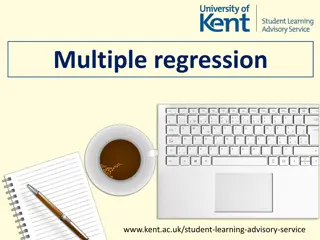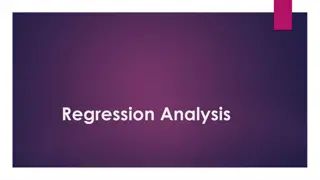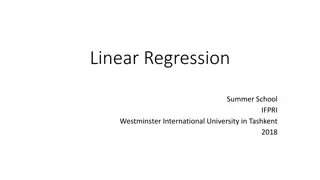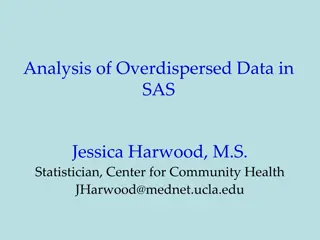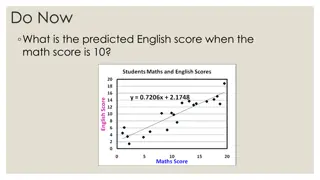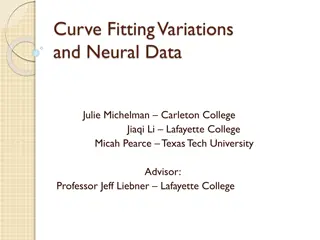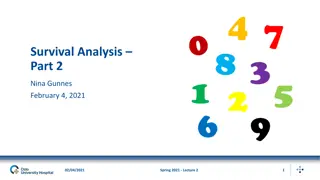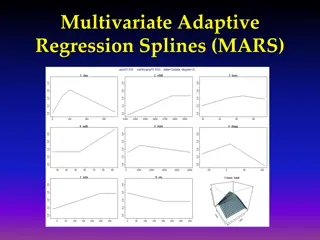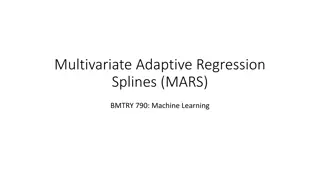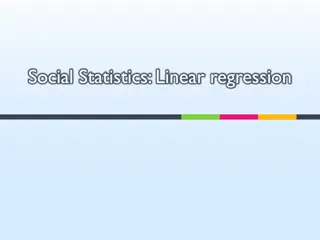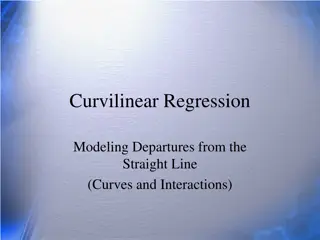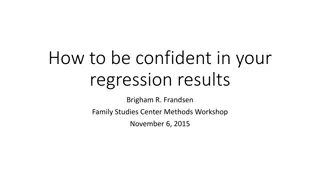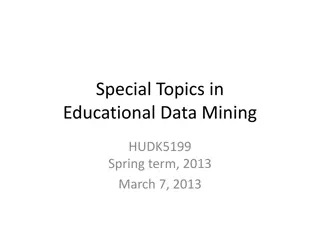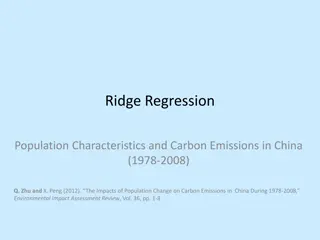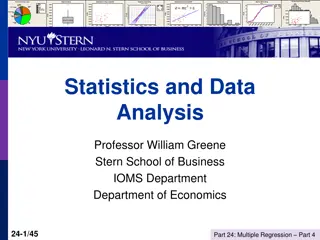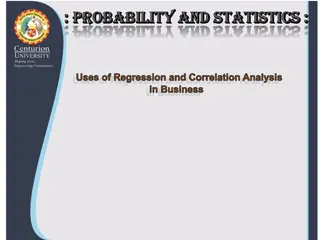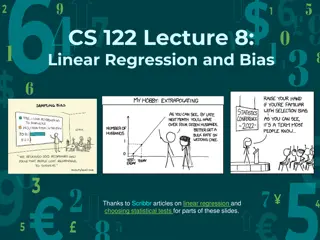Multiple Regression in Statistics
Introduction to multiple regression, including when to use it, how it extends simple linear regression, and practical applications. Explore the relationships between multiple independent variables and a dependent variable, with examples and motivations for using multiple regression models in data an
7 views • 19 slides
Regression Analysis: Meaning, Uses, and Applications
Regression analysis is a statistical tool developed by Sir Francis Galton to measure the relationship between variables. It helps predict unknown values based on known values, estimate errors, and determine correlations. Regression lines and equations are essential components of regression analysis,
3 views • 10 slides
Linear Regression: Concepts and Applications
Linear regression is a statistical method for modeling the relationship between a dependent variable and one or more independent variables. It involves estimating and predicting the expected values of the dependent variable based on the known values of the independent variables. Terminology and nota
0 views • 30 slides
Overdispersed Data in SAS for Regression Analysis
Explore the concept of overdispersion in count and binary data, its causes, consequences, and how to account for it in regression analysis using SAS. Learn about Poisson and binomial distributions, along with common techniques like Poisson regression and logistic regression. Gain insights into handl
4 views • 61 slides
Regression Lines for Predicting English Scores
Learn how to utilize regression lines to predict English scores based on math scores, recognize the dangers of extrapolation, calculate and interpret residuals, and understand the significance of slope and y-intercept in regression analysis. Explore the process of making predictions using regression
4 views • 34 slides
Curve Fitting and Regression Techniques in Neural Data Analysis
Delve into the world of curve fitting and regression analyses applied to neural data, including topics such as simple linear regression, polynomial regression, spline methods, and strategies for balancing fit and smoothness. Learn about variations in fitting models and the challenges of underfitting
2 views • 33 slides
Multiclass Logistic Regression in Data Science
Multiclass logistic regression extends standard logistic regression to predict outcomes with more than two categories. It includes ordinal logistic regression for hierarchical categories and multinomial logistic regression for non-ordered categories. By fitting separate models for each category, suc
4 views • 23 slides
Methods for Handling Collinearity in Linear Regression
Linear regression can face issues such as overfitting, poor generalizability, and collinearity when dealing with multiple predictors. Collinearity, where predictors are linearly related, can lead to unstable model estimates. To address this, penalized regression methods like Ridge and Elastic Net ca
4 views • 70 slides
Linear Regression Analysis: Testing for Association Between X and Y Variables
The provided images and text explain the process of testing for association between two quantitative variables using Linear Regression Analysis. It covers topics such as estimating slopes for Least Squares Regression lines, understanding residuals, conducting T-Tests for population regression lines,
1 views • 26 slides
Data Analysis and Regression Quiz Overview
This quiz covers topics related to traditional OLS regression problems, generalized regression characteristics, JMP options, penalty methods in Elastic Net, AIC vs. BIC, GINI impurity in decision trees, and more. Test your knowledge and understanding of key concepts in data analysis and regression t
3 views • 14 slides
Survival Analysis: Hazard Function and Cox Regression
Survival analysis examines hazards, such as the risk of events occurring over time. The Hazard Function and Cox Regression are essential concepts in this field. The Hazard Function assesses the risk of an event in a short time interval, while Cox Regression, named after Sir David Cox, estimates the
2 views • 20 slides
Multivariate Adaptive Regression Splines (MARS)
Multivariate Adaptive Regression Splines (MARS) is a flexible modeling technique that constructs complex relationships using a set of basis functions chosen from a library. The basis functions are selected through a combination of forward selection and backward elimination processes to build a smoot
3 views • 13 slides
Multivariate Adaptive Regression Splines (MARS) in Machine Learning
Multivariate Adaptive Regression Splines (MARS) offer a flexible approach in machine learning by combining features of linear regression, non-linear regression, and basis expansions. Unlike traditional models, MARS makes no assumptions about the underlying functional relationship, leading to improve
3 views • 42 slides
Social Statistics: Linear regression
Application of linear regression in social and behavioral sciences for accurate predictions and judgment of accuracy. Learn about correlation, logic of prediction, types of regression, and excel implementation. Dive into an example of predicting first-year college GPA from high school GPA using regr
5 views • 16 slides
Curvilinear Regression
Discover the nuances of curvilinear regression, polynomial modeling, and interactions in statistical analysis. Understand the challenges of collinearity, explore quadratic and cubic trends, and learn the sequence of tests to model curves effectively. Dive into the difference between linear and nonli
0 views • 31 slides
Regression Lines and Predictions
In this lesson, learn how to make predictions using regression lines, interpret residuals, and understand the importance of a regression line in data analysis. Explore the calculation and interpretation of a residual, the slope and y-intercept of a regression line, and how to determine the equation
3 views • 16 slides
How to be confident in your regression results
Delve into strategies for gaining confidence in regression results, explore weird regression tricks, and understand the social scientific process. Learn about question design, data estimation, and inference methods. Discover various design types, translation of concepts into mathematical models, dat
2 views • 10 slides
Geographic Accessibility in Health Care Planning
Accessibility to health care services is crucial for populations. Geographic accessibility, enabled by Geographic Information Systems (GIS), plays a vital role in identifying service catchment areas and enhancing health care planning. This research focuses on measuring geographic accessibility in Ta
4 views • 16 slides
Special Topics in Educational Data Mining
In the field of educational data mining, regression plays a crucial role in predicting numerical outcomes such as student performance. This content delves into regression techniques, focusing on linear regression and its application in educational contexts. Linear regression is explored as a fundame
3 views • 45 slides
Ridge Regression for Carbon Emissions in China: Population Characteristics Analysis
This study examines the impact of population change on carbon emissions in China from 1978 to 2008 using Ridge Regression. The research focuses on various population characteristics such as urbanization rate, working-age population percentage, household size, and per capita expenditures. Correlation
4 views • 16 slides
Multiple Regression Analysis Applications
Explore the applications of multiple regression analysis in assessing health satisfaction differences between men and women, computing regression equations, building regression models, and more. Discover how other factors influence the assessment process and the concept of conditional means in stati
1 views • 37 slides
Regression Analysis for Striped Sweater Itchiness
Delve into the world of regression analysis to explore the relationship between the number of stripes on a sweater and its itchiness. Discover how to calculate regression equations, predict itchiness levels, and interpret the impact of additional stripes. Explore the practical application of regress
2 views • 19 slides
Demand Forecasting in a Supply Chain Using Regression Analysis
Explore the application of regression analysis for demand forecasting in a supply chain, focusing on the relationship between time and demand. Learn about associative (causal) forecasting through regression, multiple R-squared, coefficient of determination, and interpreting regression models. Discov
3 views • 10 slides
Simple Linear Regression and Correlation in Statistics
Explore the concept of simple linear regression and correlation in statistics, where a linear relationship between variables is analyzed and predictions are made based on the regression analysis. Learn about intercept, slope, multiple regression, and the nature of regression data in practical applic
0 views • 22 slides
Statistical Analysis in Multiple Regression and Hypothesis Testing
Explore the world of statistics through multiple regression analysis, hypothesis testing, and practical applications like determining relationships in Monet paintings. Learn how to test coefficients, examine R2 values, and conduct regression analysis to investigate the significance of variables. Dis
1 views • 45 slides
Regression Analysis Fundamentals in Econometrics
Explore the key concepts of regression analysis, focusing on the conditional expectation function and population regression function. Learn about linear PRFs, the importance of stochastic disturbance terms, and the method of Ordinary Least Squares for estimating regression parameters.
1 views • 16 slides
Multiple Regression and Regularization Methods in Linear Regression
Explore the importance of evaluating regression fit, assumptions validation, feature selection, (multi)collinearity, Lasso, Ridge, splines, and more in linear regression. Learn why predictors should not be considered separately and how Ridge regression mitigates multicollinearity issues.
1 views • 6 slides
Logistic Regression: A Comprehensive Overview
Explore the fundamental concepts of logistic regression, including dichotomous response variables, the logit transformation, logistic regression model, effect measures, and more. Gain insights into how this statistical analysis technique is used to predict probabilities and estimate regression coeff
2 views • 20 slides
Regression Analysis: Methods and Examples
Learn about regression analysis, including linear regression, simple and multiple regression, estimating regression functions, and more. Explore examples of independent and dependent variables to gain insights into relationships among variables.
3 views • 15 slides
Causality and Simple Linear Regression in Statistics
Explore the concept of causality and its impact on simple linear regression in statistics. Understand the relationship between cause and effect, and how regression analysis helps predict and interpret data matrices to make informed decisions. Dive into the world of interaction variables, exchange ra
3 views • 66 slides
Regression Analysis in Predictive Modeling
Explore the concepts of regression analysis in predictive modeling, including linear regression, multiple linear regression, and numerical prediction. Understand how regression models are used to predict continuous values based on input variables, different from categorical classification. Learn abo
2 views • 20 slides
Bayesian Regression in Linear Regression Analysis
Learn about Bayesian regression in the context of simple linear regression, including prior probabilities, inference methods, and the use of MCMC for integration in the analysis of body weight loss data influenced by humidity. Explore the application of informative priors and gamma distributions to
5 views • 12 slides
Applications of Regression and Correlation Analysis in Business
Explore how regression and correlation analysis are used in business to quantify relationships between variables, optimize processes, correct errors, support decisions, and uncover new insights from data. Regression techniques like linear, logistic, ridge, lasso, polynomial, and Bayesian regression
1 views • 9 slides
Linear Regression and Bias in Statistical Analysis
Explore the concepts of linear regression, bias in statistics, and t-test reviews through practical examples and insightful explanations. Understand how to calculate error bounds, interpret t-test results, and analyze the relationship between variables using regression analysis. Dive into the assump
3 views • 22 slides
Generalized Linear Models: Understanding Regression Challenges and Transitions
Explore the challenges of linear regression in predicting binary and count outputs, transition to logistic regression for probability predictions, and delve into the Generalized Linear Model (GLM) approach for optimizing parameter characteristics in regression analysis.
1 views • 9 slides
Animal Genetics & Breeding Principles: Regression in Genetics
Understand the concept of regression in animal genetics and breeding, its significance in measuring the relationship between variables, and the calculation of regression coefficients. Learn about the relationship between correlation and regression, properties of regression coefficients, and the maxi
1 views • 17 slides
Understanding Supervised Learning - Linear Regression, Logistic Regression & Decision Trees
Explore the concepts of linear regression, logistic regression, and decision trees in supervised learning. Learn about measuring regression model quality, visualizing relationships, and finding regression lines. Experiment with scikit-learn for a hands-on experience. Discover how to determine slopes
0 views • 62 slides
Interpreting Regression Coefficients and Standard Errors
Explore the process of interpreting regression coefficients and their associated standard errors in the context of multiple regression analysis. Understand the significance of standard errors, confidence intervals, t-tests, and p-values in determining the reliability of coefficient estimates. Dive i
1 views • 19 slides
Understanding Regression Concepts and Notations
Explore the fundamentals of regression analysis including concepts, notations, regression coefficients, t-values, Multiple R and R2, and Adjusted R2. Learn about the importance of regression coefficients, standard error, significance levels, and how to interpret t-values in regression analysis. Enha
3 views • 10 slides
Regression Through Gradient Descent Optimization
Explore linear regression techniques including ordinary least squares, multiple linear regression, and gradient descent optimization for predictive modeling. Understand how regression coefficients are determined and how error functions are minimized to find optimal regression weights.
1 views • 19 slides
